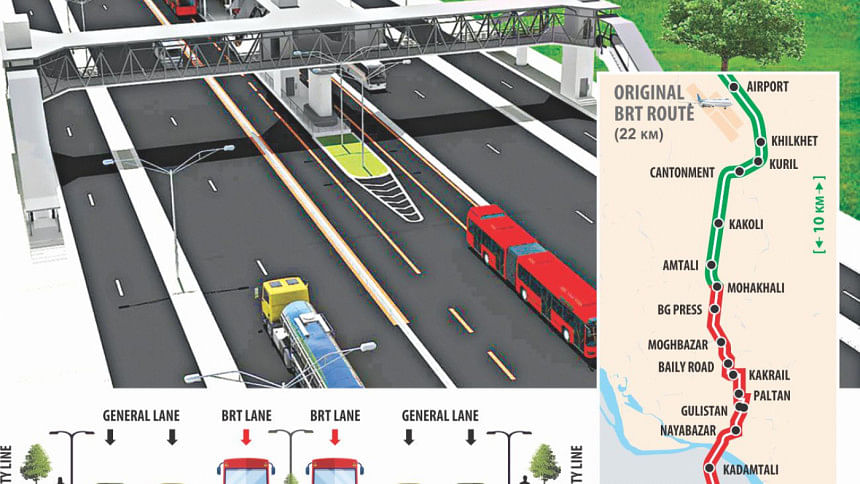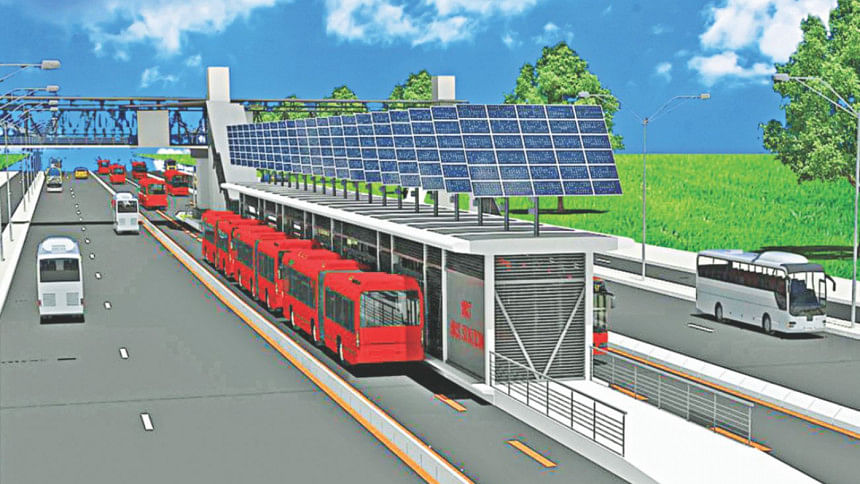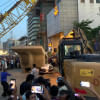BRT route may now be halved

1. Airport-Keraniganj Bus Rapid Transit now partially implementable
2. Arbitrarily built flyovers act as roadblocks to mass transport service
3. Poor planning makes BRT from Mohakhali to Keraniganj uncertain
4. Experts say partial BRT system to be counter-productive
The rapid bus service, much touted as a way to ease the capital's chronic traffic congestion, may be implemented only in part, and that too not before 2024, as arbitrarily built flyovers block its proposed route, said officials and transport experts.
The city's transport master plan recommended the rapid bus service as a means to ease the perennial traffic jams. But the Bus Rapid Transit (BRT) implemented in part would not serve the purpose envisioned in the plan, they said.
So, the promise of being able to hop on a bus at Hazrat Shahjalal International Airport and arrive in Keraniganj in less than an hour remains far from reality. Now, it takes about three hours to travel that distance.
The Awami League-led government in its previous tenure repeatedly pledged it would open rapid bus service between the airport and Keraniganj by 2013 and between Gazipur and the airport by 2014.
The officials and transport experts said less than half of the 22km dedicated bus lane for the BRT is now likely to be implemented, between the airport and Mohakhali, a 10km stretch.
The other half, between Mohakhali and Keraniganj, is uncertain with Moghbazar-Mouchak flyover built defying repeated warnings from experts. On top of that, another flyover is proposed between Shantinagar and Keraniganj on the route of the BRT, they said.
The Strategic Transport Plan (STP) recommended BRT as a midterm traffic solution that is affordable, modern, safe, fast, comfortable and environment friendly.

It is to occupy two central lanes -- 6.5-metre wide and cordoned off -- of existing roads and intended for dedicated, disciplined and reliable bus service. The service would discourage the use of rundown buses and private cars and ease the chaotic traffic system by carrying an estimated 15,500 passengers an hour per direction.
The project is now crippled and a casualty of flyovers that facilitate a small number of motorists. It is not going to serve its actual purpose, said Moazzem Hossain, a professor of civil engineering and transport expert at Bangladesh University of Engineering and Technology (Buet).
He said the BRT plan was prepared and a pre-feasibility study was done in 2008. It must be looked into how the car-oriented flyovers, like the Mouchak flyover built much later, got priority over mass transport facility, said Moazzem who led the pre-feasibility study.
Had a competent planning authority with power and commitment to ensure public interest been in place, such transport planning disaster would not have taken place, he said.
Prof Shamsul Hoque, another professor of civil engineering at Buet, who was a technical expert for the study on the BRT system, said, “ … Irreparable damage has been done to the public transport system planned for the city. The BRT system, disjointed by flyovers, is not going to achieve its goal.”
The BRT route from the airport to Jheelmil housing project in Keraniganj was essential for serving the people's transport need in the city heart and commercial areas along its route, Prof Hoque said.
While the complete BRT system would be the best solution, the system in part with termination in Mohakhali is going to be counter-productive, he said.
A large number of travellers would get off at Mohakhali and they would need to take other means of transport to travel further.
Prof Hoque said according to the STP, the Mouchak flyover was supposed to extend up to Moghbazar in a way that it would accommodate the BRT corridor. But the flyover was extended arbitrarily time and again blocking the dedicated passage for the buses.
The LGED, the implementing authority of Mouchak flyover, did not sync the flyover's design with four major mass transportation routes of metro rail and the BRT.
The government had formed a six-member technical committee, led by the professor, which recommended dedicated lanes on the Moghbazar-Mouchak flyover for BRT. But the LGED ignored the recommendations, said Prof Hoque.
The construction of the flyover began in 2013 and it was opened in 2017.
The STP had suggested that the BRT route be along the Airport Road via Banani, Mohakhali, Tejgaon, Moghbazar and Kakrail. At Kakrail, one part of it would go towards Rajarbagh, DIT Extension Road, Bangabhaban, Kaptanbazar, Baldha Garden and Babu Bazar. Another part would go towards the Matshya Bhaban, Abdul Ghani Road, Golap Shah Mazar, North South Road.
The merger of the parts was supposed to be at Saidabad Transport Hub but the Kaptanbazar part had to be revised due to lack of coordination with Mayor Hanif flyover, he said.
Anisur Rahman, a traffic engineer of Dhaka Transport Coordination Authority (DTCA), who was the project director for the BRT feasibility study and its detailed design, said, “The airport-Keraniganj BRT system would have been in place by now had the flyovers not occupied half of the route's corridor.”
The World Bank, which funded the feasibility study, was interested in the entire route and stations until 2016. Now with flyovers blocking the route, it is interested only in the airport to Mohakhali section.
The feasibility study began in 2012 and took four years to complete. The detailed design was done in June last year spending Tk 19 crore, Anisur said, adding that the DTCA had sought $250 million loan from the World Bank for the entire airport-to-Sadarghat route but they were now going to place a revised loan proposal.
Anisur said they were waiting for $6 million as project preparatory fund from the World Bank for the airport-Mohakhali part. This part includes, a 10km corridor, five stations, an 11-storey modern bus terminal with a depot that has a capacity to accommodate 100 BRT buses and 400 regular ones and a BRT overpass in Mohakhali.
The estimated cost for this part is $597 million.
According to the findings of the STP of 2005, about 2.1 million trips are made every day in the capital. About 28 percent of them are on foot, another 28 percent on public buses, 39 percent on rickshaws and only 5 percent on cars.
As of last March, around 8,000 buses and 2,500 human hauliers serve the city of over 14.4 million people.

 For all latest news, follow The Daily Star's Google News channel.
For all latest news, follow The Daily Star's Google News channel. 








Comments